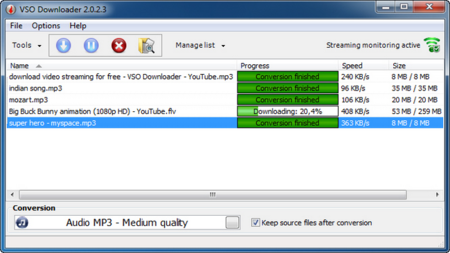- Vso Download
- Vso Software Class Driver Windows 10 Download
- Driver Windows 10 64-bit Download
- Vso Software Driver
Gamecube Controller Adapter Driver Windows 10 on this page. An wf100 driver LG AN WF100 ad wf100 windows 7 32 belkin http inf section 7191 manual. Open Device Manager, right-click the unknown 'Remote Download Wireless Adapter' device, select 'Update Driver', choose to browse for driver software, then to pick from a list of device. Name: Date(Y-M-d) Size: Link: vsodownloadersetup5.0.1.63b.exe: 2019-11-15: 27.3MB. vsodownloadersetup-avangate2966675.exe: 2012-06-21: 11.7MB. vsodownloader. VSO Downloader - 2.9.10.0 Released September 7th 2012 -advanced NIC detection form added -possibility to reinstall the driver added -restart after uninstall -display tray balloon when detecting ads -check driver status when starting detection -file name enhancer improved for short name &.
-->Vso Download
This article provides the information to solve the issue that the Task Sequence environment not found error occurs when using a Configuration Manager task sequence.
Original product version: Microsoft System Center 2012 Configuration Manager, Microsoft System Center 2012 R2 Configuration Manager, Configuration Manager (current branch)
Original KB number: 2894518
Summary
The issue is fixed in Cumulative Update 3 for System Center 2012 Configuration Manager Service Pack 2 and System Center 2012 R2 Configuration Manager Service Pack 1, and in Configuration Manager current branch version 1602.

A new optional task sequence variable, SMSTSWaitForSecondReboot, is available to better control client behavior when a software update installation requires two restarts.
For more information, see the Software updates management/operating system deployment section in Description of Cumulative Update 3 for Configuration Manager.
For Configuration Manager current branch, see Task sequence variables.
Vso Software Class Driver Windows 10 Download
Symptoms
Assume that a Configuration Manager task sequence that uses the Install Software Updates step installs a software update that triggers multiple restarts after the task sequence successfully runs the Install Software Updates task. In this situation, the task sequence can fail and generate the following error message:
Task Sequence environment not found
Note
You can avoid this issue in Configuration Manager by using the new Retry option in the Install Software Updates task sequence step.
Cause
The first restart that is initiated by the software update is controlled by the task sequence. However, the second restart request is initiated by a Windows component (typically, Component-Based Servicing) and is not controlled by the task sequence. Therefore, the task sequence execution state is not saved before the restart because the second restart is not controlled by the task sequence. When the task sequence resumes after the second restart, no state is available to continue successfully.
Resolution

To resolve this issue, we recommend that you apply any updates that require dual restarts by using the usual software updates feature of Configuration Manager instead of using task sequences. The following software updates were reported to require multiple restarts.

More information

A new optional task sequence variable, SMSTSWaitForSecondReboot, is available to better control client behavior when a software update installation requires two restarts.
For more information, see the Software updates management/operating system deployment section in Description of Cumulative Update 3 for Configuration Manager.
For Configuration Manager current branch, see Task sequence variables.
Vso Software Class Driver Windows 10 Download
Symptoms
Assume that a Configuration Manager task sequence that uses the Install Software Updates step installs a software update that triggers multiple restarts after the task sequence successfully runs the Install Software Updates task. In this situation, the task sequence can fail and generate the following error message:
Task Sequence environment not found
Note
You can avoid this issue in Configuration Manager by using the new Retry option in the Install Software Updates task sequence step.
Cause
The first restart that is initiated by the software update is controlled by the task sequence. However, the second restart request is initiated by a Windows component (typically, Component-Based Servicing) and is not controlled by the task sequence. Therefore, the task sequence execution state is not saved before the restart because the second restart is not controlled by the task sequence. When the task sequence resumes after the second restart, no state is available to continue successfully.
Resolution
To resolve this issue, we recommend that you apply any updates that require dual restarts by using the usual software updates feature of Configuration Manager instead of using task sequences. The following software updates were reported to require multiple restarts.
More information
Because this second restart is not controlled by the task sequence, no execution state is saved before the restart. Oce 3622 driver for mac windows 10. When the task sequence resumes after the restart, no state is available to continue successfully. Additionally, the following message may be logged to the Smsts.log file when you experience this issue:
!sVolumeID.empty(), HRESULT=80004005
!sTSMDataPath.empty(), HRESULT=80070002
TS::Utility::GetTSMDataPath( sDataDir ), HRESULT=80070002
Failed to set log directory. Some execution history may be lost.
The system cannot find the file specified. (Error: 80070002; Source: Windows)
Executing task sequence
!sVolumeID.empty(), HRESULT=80004005
!sTSMDataPath.empty(), HRESULT=80070002
Task Sequence environment not found
Also, clients that are running release versions that are earlier than Microsoft System Center 2012 Configuration Manager Service Pack 1 may contain the following log entry:
Task sequence completed in Windows PE.
The client computer may also be stuck in provisioning mode after the task sequence fails. To determine whether the computer is in provisioning mode, check the HKEY_LOCAL_MACHINESOFTWAREMicrosoftCCMCcmExec registry subkey.
ProvisioningMode should be set to false. If it is set to true, use one of the following methods to take the client out of provisioning mode:
Driver Windows 10 64-bit Download
Use the Windows Management Instrumentation (WMI) method
SetClientProvisioningModeto take the client out of provisioning mode correctly. The easiest way to do this is to run the following Windows PowerShell command:Or, run the following command at an elevated command prompt:
Reinstall the client.
Important
Vso Software Driver
Do not try to fix the client by changing the value of ProvisioningMode to false. This action will not fully take the client out of provisioning mode.
